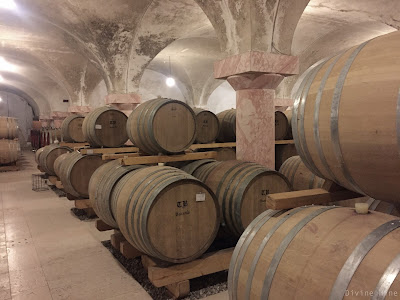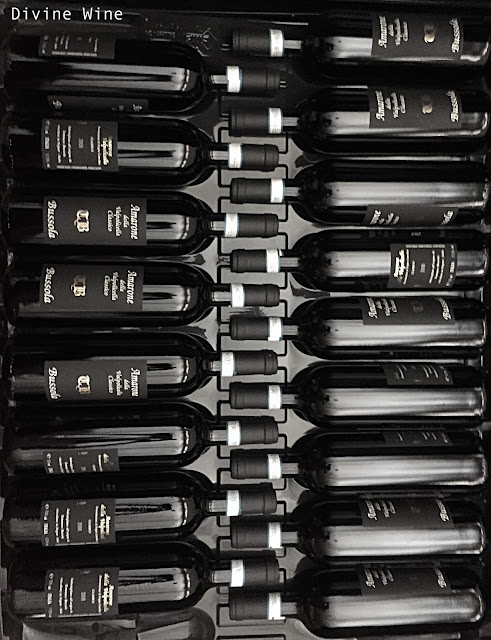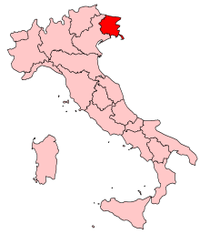 |
| Poetry of the tonneaux at Tommaso Bussola. |
The first
thing I notice is the silence. Admittedly, I’ve listened to our screaming
rental car for the last hours, and finally the car is parked, but there is more
to this feeling. As I keep on sensing, I can only hear the crickets and feel
air staying put - the non-moving heat of a blazing summer day. All this
stillness is accentuated by the minimalistic surroundings: the drive way
entrance is a simple wall of white stone; the white winery with red brick grape
drying rooms stands alone facing an open yard; a stack of pallets awaits the
next wine shipment. There is nothing extra. This is when I realize that this
place is Zen. What is essential, it is there.
When
Giuseppe Bussola, Tommaso’s son responsible for winery’s PR and office,
welcomes us, my first impression is confirmed. Out of us two I’m the talkative
scandinavian who keeps on babbling, while he answers my questions quietly, with
a friendly smile. Gradually his presence calms me down, and I find myself able
just to listen. And this is when Giuseppe tells me the story of how Tommaso
Bussola winery got started.
 |
| The white family house is attached to the winery. |
Originally,
Tommaso Bussola didn’t work with wine, but his uncle Giuseppe, namesake of our
host, did. When Tommaso decided that he didn’t want to work in office surroundings
anymore, Giuseppe introduced him to vineyard work. Tommaso became passionate
about vineyard management, and later the art of winemaking. While Giuseppe was more a man of quantity than
quality, alongside with Tommaso a change was about to come. The quality of the
wine became an absolute guiding star.
In Barolo to Valpolicella (2004) MW Nicolas
Belfrage, an expert in Italian wine writes that when high quality winemaking became
Tommaso’s passion, he kept painstakingly aiming at his goal. He took a loan to
build his family house and winery with all the things necessary for making best
possible wine from start to finish. The results of this determination were soon
evident - and what kind of results were they! When Belfrage asked the legendary
Amarone producer Giuseppe Quintarelli (1927-1912) whom he particularly
recommended among the younger generation in Valpolicella, Quintarelli gave only
one name: Tommaso Bussola.
 |
| Giuseppe introducing the cellar. |
Walking
alongside Giuseppe in Bussola’s cellars I realise that I’ve come to a temple. Again,
Zen is in the air as the rustic, peach tinted arched vaults carry the weight of
the winery with robust grace, protecting the magnificent five-hectoliter
tonneaux. The rhythm at which these medium-sized Slavonian, American and French
oak casks are arranged in the cellar space is sheer poetry. Giuseppe tells that each year there are 60
000-70 000 bottles of wine ageing in these tonneaux: Valpolicella classico,
ripasso, and their especially celebrated Amarone and Recioto.
Bussola’s
wines are divided into two deparate lines. The oak used for the basic line
wines is in its second or third passage, while only new oak is used for the TB
line. Covering 14 hectares, Bussolas vineyards are mostly planted with
Valpolicella’s traditional grape varieties Corvina, Corvinone, Rondinella,
Croatina and Molinara. The vineyards are located in three different crus: Ca
del Laito lies just below the winery, while Vigneto Alto and Casalin are a few
kilometres away. A small vineyard area also produces international varieties
for more experimental wines like L’Errante, an international red blend made
with Amarone technique, and Peagna, a white dessert wine made partially of
local varieties and partially of Chardonnay. Peagna is produced in a very small
quantity and only in the best vintages.
At harvest
time, the grape picking is done with meticulous precision. Five, even six
visits may be paid to the same patch of vineyard to pick only the optimally
ripe grapes. Bussola aims at producing all their three Amarones every year.
Their principle is that any of the Amarones will be left unproduced in case the
grapes do not match Bussola’s quality standard. Also, this goes for any of
their other products. For example, in 2013 and 2014 hail and rain destroyed 2/3
of the crop, hence basic line Valpolicella classico was not produced at all.
 |
| TB line Amarone della Valpolicella Classico is ready to travel. |
In the
tasting room everything Giuseppe has told becomes tangible reality as we are
presented with the following works of art: Valpolicella Ripasso Superiore Ca
del Laito 2011, Valpolicella Superiore TB 2010, Amarone della Valpolicella
Classico 2009, Amarone della Valpolicella Classico Riserva TB 2008, and
finally, Peagna. At the time of our visit a new vintage of Recioto is just
being bottled, while Valpolicella Classico is sold out, so unfortunately these
can’t be tasted right now. In the following, I’ll sketch the general experience
of the tasting for you. To do these wines justice, I’ll post separate, more
detailed wine review posts of chosen wines at a later point in time.
Because
Valpolicella Classico is not available, the tasting starts with cru Ca del
Laito wine made with ripasso technique. Boom! I’m being knocked me off my feet
by the very first wine. I can’t stop marveling the intensity of its particular
cherry aroma. Together with a sophisticated almond aroma the cherries resemble
those marinated in maraschino liqueur. Further, the structure of this wine is
impressive: acidic, concentrated, with ripe and plentiful tannins. The high alcohol
is well balanced with the abundance of structural elements.
Ca del
Laito ripasso being the entry-level wine of the tasting, you can just imagine
the development as we travel through the basic line Amarone, TB line ripasso
and TB line Amarone. Simplicity is replaced with more complexity; concentration
becomes, if possible, even more concentrated. What stays is the impression of
maraschino cherries - the intense and fresh cherry primary fruit accompanied
with almond flavour. Depending on the oak usage, there is more or less oak influence,
vanilla and toast.
Amarones, not
surprisingly, are the most deep and complex out of the wines with floral,
liquorice and spice aromas. The wines that have matured the longest are very
layered, and still the freshness of their fruit remains pristine. 2008 TB
Amarone gets a special mention form Giuseppe for its particular aromatics: this
vintage was exceptionally hot in Valpolicella and producers struggled with
jammy fruit aromas. Nonetheless, in 2008 TB Amarone the fruit remains bright
and fresh. Finally, the finish of every wine is extensive, vibrant and fruity.
Dear vinous friends, up until now Amarone in general has been slightly too
fruit driven for my taste. However, these wines have changed me, to say the
least. I’m impressed.
While we
thank and say our goodbyes Giuseppe expresses his regrets we didn’t get to
taste their Recioto - the wine that is particularily important for Bussola. While
I’m of course curious of this wine, I have no problem with leaving with such a
good excuse to return for a new visit in the future! And, on top of that I’d
like to taste their basic line Valpolicella classico, as I’ve got inkling it
might change my idea of Valpolicella normale entirely.
Coordinates
Azienda Agricola Tommaso Bussola
Via Molino Turri, 30
37024 Negrar
bussolavini.com
info@bussolavini.com
Tel. 045 7501740









